Profiles published by date: Simon Lynds; Hank Thomas = Santa; San Francisco Quilt Shop; Sergio Avila; Adán Pérez ;Dario Veliz, the creator of Casa Country; Horacio Palencia; Alexis Félix ;The passions of Alfredo Gómez Rubio; Sixty minutes with Gabriela Rodriguez Garcia; Retrato de un artista, Antonio López Saenz; It’s more than stilettos and a crown; Lori Davidson; Rafael Rodriquez; Claudia Lavista;
Simon Lynds. You have no idea.
By Sheila Madsen, December 2023
It can take years to really know someone: their values, their beliefs, how they experience personal and medical issues [not to mention the death of close friends], reactions to events beyond their control like hurricanes and the last big scary one – a Covid pandemic. I’d like to think that I’ve seen all sides of Simon in the 13 years we have been friends – but I probably haven’t. He has helped so many people in Mazatlan with so many things, I thought it was high time you get to know this UK entrepreneur.
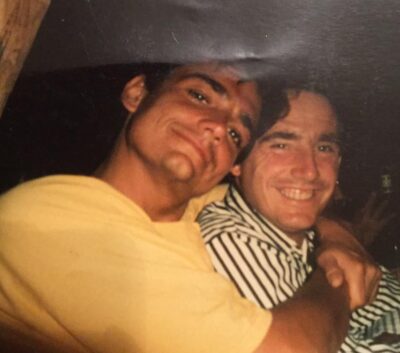
Simon and his brother Vincent.
Before Simon landed in Mazatlan on a whim in 2004, he was extremely busy in the UK climbing his way up the various media and advertising ladders. Born in Dartford England, and growing up in Gravesend, he was not to the manor born. His father was a machine operator at a power plant and his mother was also a machine operator in a toilet roll factory. To make ends meet she also took at second job as night cleaner in railway carriages. Sadly, his dad died at 40 and his mother died 20 years later. His brother Vincent became, and is, a policeman, a copper.
His very first job was on a tug boat as a cook. Simon can’t cook, he can barely shop for groceries. He sweet talked his way into that job, but talk only lasts so long – like 24 hours. When the chef, returned for his shift he saw Simon staring at the bags still filled with lamb, beef, potatoes, all the things you would serve a hungry crew for a proper Sunday lunch. “I hadn’t even unpacked the food, I had no clue of what to do.” The boss said “get out and go clean the upper deck. You are useless in the kitchen”. Fired on day one, while the crew chewed on baked beans on toast.
Again, with no experience, he applied for a media internship at the prestigious advertising agency Ogilvy and Mather in London. His headhunter didn’t want to send him on the interview as the agency already had a short list of six excellent candidates. However, sweet-talking Simon happened to have a head for numbers – and you need that if you are going to be negotiating media rates for air time/space in tv, radio, magazines, billboards, tube stations etc. Question: what is 7% of 7. Answer: .49.

Serious Simon in his UK advertising days.
Simon got the job and two years later he jumped to another respected ad agency, McCann Erickson. At the age of 23 he became the deputy head of tv. Advertising is a young people’s world, but to hold an important position at 23 is an extraordinary achievement. During the next ten years Simon’s negotiating skills were in high demand and he eventually started his own company, Wood Lynds. The media giant US Katz Media Group bought his company, and Simon stayed on as CEO until 2002. That was a huge win for Simon and it changed his life.
The wining, the dining, the parties, the swag bags, the concerts, the constant selling and entertaining became exhausting for Simon. He wasn’t sure of his next move or even if he wanted to remain the UK. He had travelled all through the United States and most of Europe – on business and for pleasure. His friend’s suggestion of Mazatlan seemed like a good idea and jumping off point for exploring the west coast. Simon fell in love with the ocean, the beaches, the warm open Mazatlecos, the food, the cost of living and the sunshine. He may have been a party animal in the UK but never married. In Mazatlan, boy meets Mexican girl, falls in love, gets married and they had a beautiful daughter two years later. The couple agreed to speak English at home and Spanish outside, so the family is bilingual.
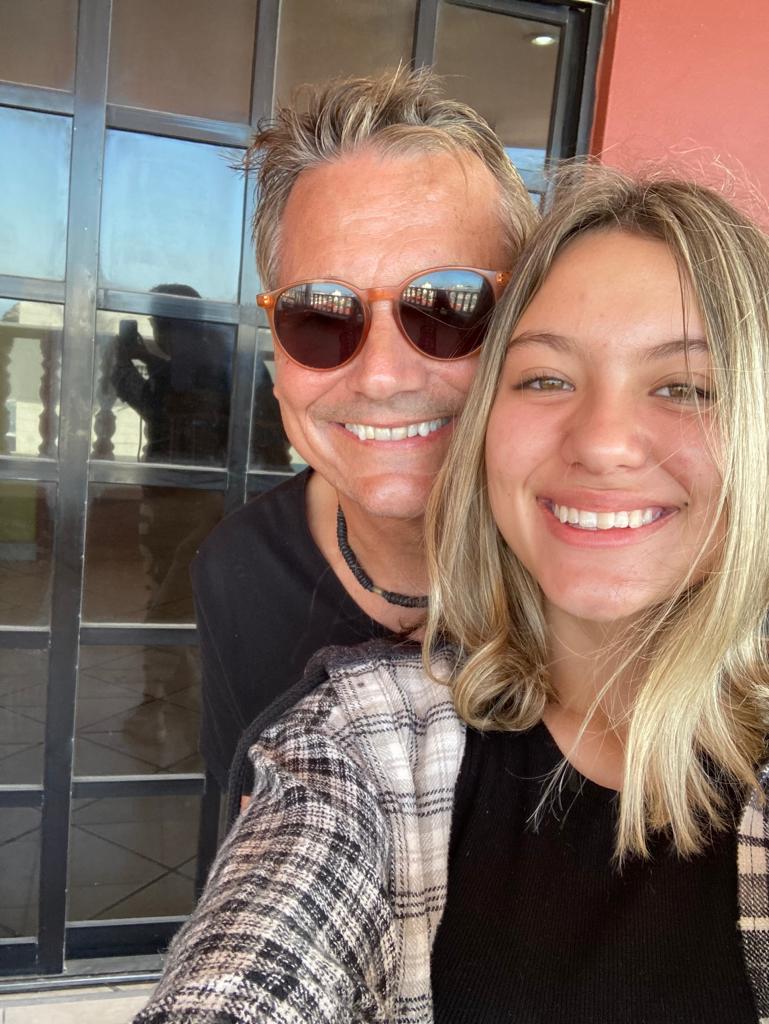
Father and daughter. Blondes have more fun.
“One of my proudest achievements is that I’ve been able to be with my daughter every single day; from her first day at school, to teaching her how to drive, watching her working as a waitress in a local beach bar, prepping her for her university applications, I’ve been there for it all.” He chose to stay close to his family while keeping busy creating and promoting events in Mazatlan.
Simon never explored the west coast.

Since 2014 – bigger and better than ever.
Years ago, Simon liaised with tourism and created International Week. From that, Mazatlan Rocks the Beach was born in 2014 and is still going strong ten years later. It’s rock and roll on the beach, but a large portion of the proceeds are donated to two charities. Giving back is vital to Simon and that’s one of the reasons he continues to organize these beach parties. You see, you had no idea. He was involved with Venados Baseball and created The Friendship Series which enabled 10,000 children to attend their very first baseball game. Simon even created scholarships for young boys to attend college in the US. Simon quietly donates and supports many charities. Over the years I’ve had many quotes from people who have worked closely with him on various projects and without fail, they are all complimentary: “Simon is a man of his word, he gets things done…no one can co-ordinate an event like Simon…he treats everyone with respect, but if things aren’t 100% you’ll hear about or he’ll pull the plug…Simon is the very first person to reach out and help, like teaching English in the poorer areas…he always returns my phone calls and if he can’t help he will connect me with someone who can…” You see, you had no idea.

An opportunity for 10,000 children to see their very first Venados baseball game.
With his daughter heading off to university I asked Simon, besides your current projects, what’s next? “I am going to launch an investment and real estate company focusing on the international market. It will be innovative and open up the Mazatlan market in Europe and the US and possibly other countries.” That sounds a little vague, but you can be sure Simon is laser focused on this and it will be a success. When he’s not in meetings, or on the phone, he takes time to watch his beloved UK football teams, he reads, and plays pickleball three times a week. He’s also a movie buff.
I surprised Simon with a mash-up of questions from Marcel Proust, Vanity Fair and The Guardian.
What is your idea of perfect happiness?
Seeing the smile on my daughter’s face.
What is your greatest fear?
Snakes.
What is the trait you most deplore in yourself?
Lack of patience.
What is the trait you most deplore in others?
Lack of integrity.
Which living or dead person do you most admire?
My mother.
What is your greatest extravagance?
Wine.
On what occasion do you lie?
When I can’t face the truth.
Which words or phrases do you most overuse?
Mate. Brilliant. “That’s the best [insert any food ] I’ve ever had.”
Which talent would you most like to have?
To sing.
If you were to die and come back as a person or a thing, what would it be?
Mohammod Ali.
What do you most value in your friends?
Loyalty.
Who are your favorite writers?
John le Carré, Charles Dickens, P.D. James.
What is your greatest regret?
Not having more time with my father.
How would you like to die?
Fighting, not letting the old man in. Surrounded by my family.
What is your motto?
Integrity, respect and loyalty.
What’s your favourite smell?
Vanilla.
What’s your favourite noise?
The surf rolling in.
What’s your least favourite noise?
Banda on the beach
If you could bring something extinct back to life, what would you choose?
The Dodo bird.
Who would play you in the film of your life?
Daniel Day-Lewis.
Who is your celebrity crush?
Julia Roberts.
What turns you off?
Bad breath.
What are you passionate about?
Family, football, and friends in equal measure.
What turns you on creatively, spiritually or emotionally?
Fantastic ideas from anybody.
If heaven exists, what would you like to hear God say when you arrive at the Pearly Gates.
Football is on a 2:00 pm, we have time for quick beer.
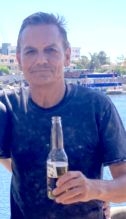

Meet Hank Thomas = Santa.
By Sheila Madsen, October 2023
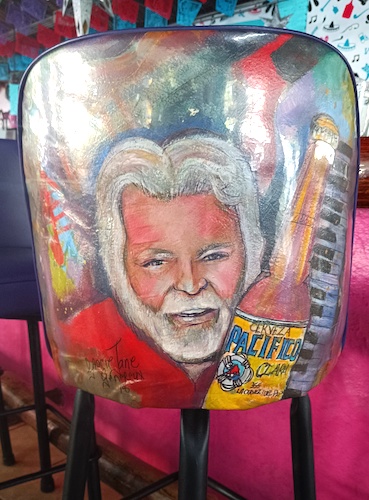
Hank has agreed to meet me at his home away from home, La Catrina Restaurant. That’s his chair you see in the photo above. His very own chair at the bar. Who has that? Hank does and you’ll see why.
Wanting to know more about Santa/ Hank I asked “if you had to write your profile for a dating site what would you say.” Hank laughs and shakes his head, “I would never go on a dating site, I wouldn’t write a single thing.” Prodding him, “come on, let’s pretend.” He agrees to this: I don’t dance, I don’t play an instrument, I don’t sing, I love to listen to live music, I like women but I don’t want a woman, I am out every night listening to different bands, I never have a hangover, I don’t own a car, I never miss a Sunday Mass, I have a season pass for two, to the Venados baseball game, I own 75 tank tops, I have 20 pairs of shorts, 10 pairs of flip flops and there are 10 beers in my fridge. I get up around 7 am, sit on my patio that overlooks the ocean and I just enjoy watching the waves and relaxing. I read two newspapers from America, and two of our local Mazatlan papers because I can get the translation on-line- Noroeste and El Debate. I check my e mail, MazatlanLife for music and FaceBook, then often I make myself a breakfast of eggs, toast, beans and bacon. I may not eat again that day, but I may have a few Pacifico beers. I have no real plans, just to visit my friends, listen to the music I love- mostly rock n’ roll. I have the best of both worlds; I wouldn’t change a thing. And now you can see why I’d never put all that on a dating profile!”
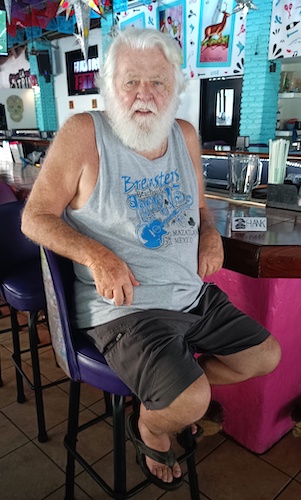
So, that’s today in Mazatlan. Seventy-nine years ago Hank was born in a little town called Brookfield Ohio, and he spent 30 years working for General Motors in the electrical engineering department. While he was working, he had two marriages [not at the same time] “but I’m still friendly with both of my ex -wives”. He travelled to every continent and almost every country in Europe. Ask Hank about Sweden, England, Australia or China and he’s probably been there. Ireland remains one of his favourite countries. “My mother’s family was from Germany and my Dad’s family was mix of Irish and Welsh. I loved to travel, to explore, to strike up conversations -no matter the language barrier – I was a true traveller.”
When Hank retired from GM, he and his motorhome drove the east and west coast of Mexico. He didn’t just arrive in Mazatlan put down roots. He saw all of Mexico. At one point he thought San Felipe in the Baja may be a possible retirement place but “it was too cool at night. I had to wear a jacket and I thought if I’m cold, I’d rather be in Ohio in front of a fire. I looked at the map, looked south and thought I would give Mazatlan a try. That was in 2000. “At long last, I found my home.” After 23 years you can imagine the deep friendships Hank has created and treasured.
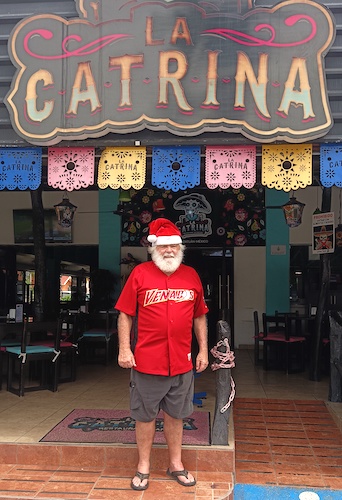
“I’ve had a beard since 1979 – I can’t remember when it went white- but when I moved to Mazatlan, Mexicans and expats started calling me Santa. When I go into a restaurant, the staff write “Santa”, not Hank, on my bill. I don’t do Santa gigs, I don’t give out presents – that’s just not me, but I will put on the Santa hat and help out The Brenster at his Tuesday Beach Bash giving out – what else, beer.”
“Speaking about The Brenster [ Brent McAthey] don’t you want to know about THE CHAIR?” Why, yes, I do. “Years ago, The Brenster quietly took a picture of me, and a friend of his in Canada did a drawing, sealed it in vinyl and Brent brought it back to Mazatlan. Jesus, the owner of La Catrina, secured it as wrap -around on the back of a bar stool. The Brenster loves to surprise his friends; it’s not unusual for us to meet at La Catrina and one night he suggested we to listen to a group. We walk in and he points and says, ‘there ya go pal, your chair forever.’ “It’s my bar stool from October to May and when I leave for Ohio, the staff tucks it away. Just the other night a young woman was sitting in it; I walk into La Catrina and the polite waiter whispers ‘Santa/Hank is here, I’m afraid you are going to have to move.’ It was no problem, she sat next to me and I took her to a Venado’s baseball game the next night as my guest – that’s why I like to buy two tickets to repay so many of the kind and hard-working people here in Mazatlan.”
Like so many of us at a certain age, we have our routines. Hank will never miss a Brenster Beach Bash [unless there is a Venado’s game], he’ll try to be on his patio for a stunning Pacific sunset and a Pacifico beer, he’ll be a Nasha’s maybe for breakfast or ribs, at Barra al Mar [BAM] for reggae and at Los Zarapes for the music. La Catrina [ex Purple Onion, ex Three Amigos] just announced its vibrant music line-up and it’s simply too good for Hank to miss – from Monday to Saturday you’ll find Hank on his bar stool in the late afternoon often until 2 am. Oh, don’t worry,he won’t ever miss his Sunday Mass.
This kind, warm man in his signature tank tops, has travelled the world and yet he has chosen Mazatlan as his winter home. He’s at peace with all his decisions and turning 80 in May doesn’t bother him one little bit. “I’m the baby of the family, my siblings are older so I am going to my summer home to celebrate with my family. Family is everything.” And when Santa/Hank says family, he includes all his dear friends here in Mazatlan. Pull up bar stool, introduce yourself and bask in Hank’s warmth and positive vibes – it won’t be long before you are part of his family too.
What’s new with San Francisco Quilt Shop?
Updated May 2024 – the quilt shop is currently closed and is moving to Libertad #44 and will re-open in October 2024.
By C. Michaels. [stolen with permission from the November 2018 issue of the Pacific Pearl. C. Michaels is an author living in Mazatlan. You may enjoy her FB page]
Linda Hannawalt and her quilt shop; this woman’s attitude can make anything happen.
Well, it’s happening.
I recently asked her, “What’s new?”
“We’ve gone to many shows in Mexico this year. We’ve also made quilt kits.” She pointed across the room where the quilts and kits were displayed. “We have this floor devoted to fabrics, and the upstairs is for classes.” Proudly, she added, “As of this month, I own the shop, so we are here to stay… we’re teaching three class a week now. Plus, Thursday afternoons and Saturday mornings, we’ll be teaching a free class to those who want to do community work.”
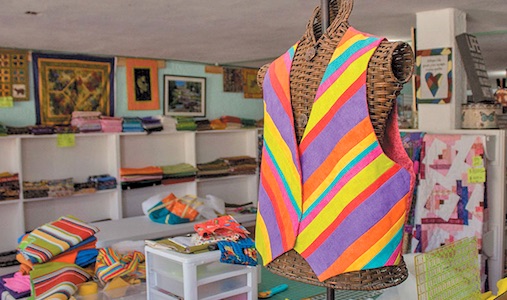 Next, Linda spoke about the quilts she and others in her shop are making for blind children. “I had saved piles of interesting textured fabric scraps with the intention of one day turning them into quilts for the blind.” She smiled, “When I have an idea in my head, magical things happen. I met with a girlfriend at a sunset party, and mentioned that I wanted this, but didn’t know how to find blind children in Mazatlán. My friend knew the teacher at a blind school right in town! The following week, my granddaughter and I went and met the kids, 30 of them, who range between five-years old and up in their teens. That event changed my life.”
Next, Linda spoke about the quilts she and others in her shop are making for blind children. “I had saved piles of interesting textured fabric scraps with the intention of one day turning them into quilts for the blind.” She smiled, “When I have an idea in my head, magical things happen. I met with a girlfriend at a sunset party, and mentioned that I wanted this, but didn’t know how to find blind children in Mazatlán. My friend knew the teacher at a blind school right in town! The following week, my granddaughter and I went and met the kids, 30 of them, who range between five-years old and up in their teens. That event changed my life.”
Soon, Linda was to learn a lesson… the quilts needed to be built with multiple textures for the blind to run their hands through; scratchy, bumps and lumps… but also for the parents to see. Coordinated colors were as important as the textures. “We’re in the process of making 30 quilts to give to the students of this school for Christmas. One of my volunteers came up with the idea of adding pockets to put small toys into.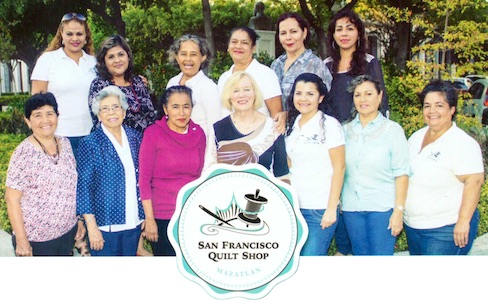 I need to be very clear, I do not do this by myself. So many are part of this team.”
I need to be very clear, I do not do this by myself. So many are part of this team.”
Then her gigantic project came up, the Mazatlan International Quilt Festival happening March 29 and 30 at El Cid Resort. Its theme? The Magic of the Ocean.
“Our guest artist, Velda Newman, is a master quilter from Northern California. She’s known for her gigantic quilts… my favorite is eight by 22 feet. It took her three years to complete, all the work done by hand, and is worth $75,000 USD. Additionally, Janet Mednick and Jeanne Matysiak, two great artists, are bringing some of their quilts. I have key teachers in the Bay Area secured to teach classes in five salons at El Cid. Vendors are coming from all over Mexico, and we’ll have many demonstrations. Quilts from 15 countries will be displayed; one hundred quilts where 25 of them are over 100 years old to display the past. We will have quilts made by kids under 18 to show the future, and the others will be from the present. Key quilters will judge them for each category. We’ll also have a clothing category to be judged. Tickets will go on sale this month, but I expect most people will be walk-ins. The admission is 50 pesos. Currently, we are the only quilt shop in Sinaloa. Other than Mexico City, ours will be the only place to host a festival/expo like this in Mexico.” She smiled, “I have a dream that in five years, this festival will be as large as Moto Week, just a different pool of passionate people to enjoy Mazatlán.”
I hope you can come see this energetic woman and learn about the quilt hoopla March 29 and 30. This event promises to please all.
[The San Francisco Quilt Shop is located on Carnaval #1005, at Roosevelt and is open from Tuesdays to Saturdays from 9 a.m. to 5 p.m. but do call ahead – 669 668 3247.They are #19 on ArtWalk. “Largest full service quilt shop in Mexico. Thousands of fabrics, long arm service, handcrafted items and quilts, classes taught in English and Spanish.”]
Sergio Avila, all by myself.
By Sheila Madsen, November 2017
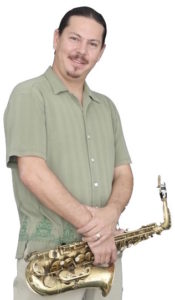 You’ve seen and heard Sergio and his sax all around town, playing by himself – “I’m so good when I am by myself!” His career didn’t start solo in Mazatlan though. His music mentor, Nestro Landeros, played the piano but Sergio was not captivated by the keys [he does play the piano now] and wanted to learn the saxophone. There were no sax teachers and almost no saxophones available in 1986 in Mazatlan. Nestro eventually found a sax and gave it to the 15 year-old Sergio.
You’ve seen and heard Sergio and his sax all around town, playing by himself – “I’m so good when I am by myself!” His career didn’t start solo in Mazatlan though. His music mentor, Nestro Landeros, played the piano but Sergio was not captivated by the keys [he does play the piano now] and wanted to learn the saxophone. There were no sax teachers and almost no saxophones available in 1986 in Mazatlan. Nestro eventually found a sax and gave it to the 15 year-old Sergio.
To avoid disturbing the neigbours the teenager took to practicing in the family shower. He had a sax manual [now, now, you know what I mean] and listened to hundreds and hundred of records. His dad was an English teacher and loved all kinds of music – from classical to rock. Dad also bought the Reader’s Digest Record subscription so the vinyl flowed through the Avila household. “Dad loved listening to music [Ray Conniff, Charlie Parker, The Beatles] but he didn’t play an instrument – just the door bell.”

After high school and a diploma in computer science, Sergio joined/formed the band Hamlet that later morphed into Hechos Raros. With this Spanish rock and roll band [already speaking fluent English] the young sax player performed in LA, Houston, Chicago, Miami, and all the big cities in Mexico. In his early 20s Hechos Raros made a record deal with the Mexican group Fonovisa. The famous Mexican singer/songwriter/actor Pepe Aguilar also discovered Hechos Raros and promoted them; they enjoyed many successful years in Mexico City and other cities.
His music college was live, up close and personal. Sergio watched every group, watched the lighting, the recording, the mixing, every nuance was stored into his database. “I don’t drink, smoke, do drugs, I don’t even drink a beer, so I had lots of time to observe and keep the best of what I saw.” Then the gigs, the travelling no longer excited Sergio – he went solo in 2006.
I asked him if he was lonely, if he wished to have a singer accompany him, or to be part of something larger. He returns to his opening quote “I’m so good when I’m by myself. When I’m playing in a restaurant I can change the mood, the ambience. To me people are having a really good time if they are talking. I’m not a concert, I’m just part of scene.” Today he’s out of the shower, has a mini recording studio, owns three alto saxs and even if he has a gig, he practices three to four hours a day. “I need to rehearse the new songs from Adele, and songs like Ed Sheeran’s Thinking Outloud.”
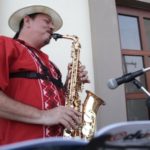
Sergio is a super-calm enthusiastic man, who’s really happy with his life in Mazatlan and it was no problem for him to find balance for his music, his friends and his family. Smiling he says “I feel really good with my first 30 years of my saxophone!”
Here are his answers to the classic Bernard Pivot questions:
If you could play on any stage in the world where would it be: Bellas Artes
If you could play with any group, dead or alive, who would it be: Pink Floyd
What is your favourite word: love
What is your least favourite word: politics
What turns you on creatively, spiritually and emotionally: solitude
What turns you off: noise, a crowd
What sound or noise do you hate: banda music.
What profession other than your own would you like to attempt: teacher [anything but music]
What profession would you NOT like to do: politics
If heaven exists what you like to hear God say when you arrive at the Pearly Gates: Finally!
[You’ll find all of Sergio’s gigs here, under THE FAIRLY ACCURATE DAILY MUSIC SCHEDULE – La Magia del Sax. Feel free to request a song – some of the most popular ones are Hallelujah, My Way and All of Me. His cds sell for $50.]
Mazatleco opera singer brings banda to New York. What?
By Sheila Madsen, June 2017
 I thought getting an interview with José Adán Pérez would be difficult, probably impossible. He’s not only a famous opera singer, but he’s in Mazatlan enjoying a rare holiday with his family. Adán hadn’t been home in three years and I doubted if he would want to take time. Adán could not have been more accessible or willing. We set the date by text, he responded quickly and we met a Gaia Bistrot – he was five minutes early. This was no temperamental opera star. This was a Mazatleco bubbling over with passion, enthusiasm and a zest for life. Adán arrived in a New York Yankees baseball cap, a bright orange shirt and shorts; his big brown eyes were buzzing with excitement and he was ready to share the news of his latest venture.
I thought getting an interview with José Adán Pérez would be difficult, probably impossible. He’s not only a famous opera singer, but he’s in Mazatlan enjoying a rare holiday with his family. Adán hadn’t been home in three years and I doubted if he would want to take time. Adán could not have been more accessible or willing. We set the date by text, he responded quickly and we met a Gaia Bistrot – he was five minutes early. This was no temperamental opera star. This was a Mazatleco bubbling over with passion, enthusiasm and a zest for life. Adán arrived in a New York Yankees baseball cap, a bright orange shirt and shorts; his big brown eyes were buzzing with excitement and he was ready to share the news of his latest venture.
At only 41 years old, Adán has been showered in successes in each of his careers. One as an engineer, one as an opera singer and one as lead singer and founder of Banda Nueve York. As a boy growing up in Mazatlan’s Centro he attended several music schools and later went to university and graduated with an engineering degree. After four years of toiling away in Mexico City in the auto industry Adán realized how much he missed his music. The engineering world no longer interested him.
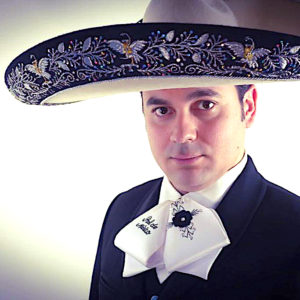 “I’m crazy, I like to take risks and if the music world failed me I could always fall back on my engineering skills.” Turns out he didn’t need Plan B. The baritone graduated from The Academy of Vocal Arts in Philadelphia and made his stage debut in 2007 at the LA Opera with Puccini’s La Bohème conducted by Placido Domingo [who was also one of his maestros]. The past ten years have brought Adán nothing but rave reviews [Figaro 90210, for instance] and his agent has opera engagements booked until 2021.
“I’m crazy, I like to take risks and if the music world failed me I could always fall back on my engineering skills.” Turns out he didn’t need Plan B. The baritone graduated from The Academy of Vocal Arts in Philadelphia and made his stage debut in 2007 at the LA Opera with Puccini’s La Bohème conducted by Placido Domingo [who was also one of his maestros]. The past ten years have brought Adán nothing but rave reviews [Figaro 90210, for instance] and his agent has opera engagements booked until 2021.
Along the way he met and married Michiyo Morikawa. This vibrant Japanese woman is a classical pianist and when she and Adán travel to Tokyo the Mexican Embassy invites Adán to sing in the local Mariachi Samurai band – yes, he speaks Japanese [along with a gazillion other languages]. He’s also invited by the New York Mexican Embassy to perform on important holidays such as Independence Day. Although he travels in the rarefied air of opera, he’s not afraid to don a mariachi outfit and belt out those songs.
And, because he’s from Sinaloa banda is near and dear to Adán’s heart. Now we are moving into his banda phase and the time is around 2015. Adán and Michiyo have a three-bedroom apartment in New York and they frequently spend their evenings with other successful musicians. Out comes the mezcal, out comes the tequila and instead of a hangover – Banada Nueva York was born. Adán contacted several of the most popular Sinaloa bandas [El Recodo, La Original Banda El Limón] and they sent him sheet music for the group of 16 to learn.
 The rehearsals take place in their apartment, “we all squeeze in and hug like Mexicans”. I couldn’t help but wonder how the neighbours felt about these sessions and perhaps out of consideration the group has found four places to practice in, frequently with a live audience; El Museo Barrio in Harlem, El Patron Nightclub in the Bronx, La Boom Nightclub and Shrine. Often there’s no cover charge as the Banda Nueve York announces to the audience “these are a live practice sessions, it’s our laboratory and if we make a mistake we’ll re-do the song.” The audience is mostly comprised of enthusiastic dancers from the Dominican Republic who don’t even notice the do-overs.
The rehearsals take place in their apartment, “we all squeeze in and hug like Mexicans”. I couldn’t help but wonder how the neighbours felt about these sessions and perhaps out of consideration the group has found four places to practice in, frequently with a live audience; El Museo Barrio in Harlem, El Patron Nightclub in the Bronx, La Boom Nightclub and Shrine. Often there’s no cover charge as the Banda Nueve York announces to the audience “these are a live practice sessions, it’s our laboratory and if we make a mistake we’ll re-do the song.” The audience is mostly comprised of enthusiastic dancers from the Dominican Republic who don’t even notice the do-overs.
The group does have paid gigs but in reality it’s a financial investment for everyone. Many of the musicians are from Broadway [“The Lion King”, “An American in Paris” who were part of the philharmonic orchestras in Lincoln Center, Carnegie Hall or jazz clubs across New York] and are not Mexicans. However, they all seem to embrace the banda sounds – “we’re just trying to enjoy and have fun with it.”
New York has one of the largest Hispanic populations in the United States and Banda Nueva York is certainly gaining traction. They just released “Noche de Pasión” [you can listen online or YouTube, or Spotify ]”with lyrics appealing to the people who work and live here in the United States. We like to express the fears, desires and needs of the Mexican-American community.”
If for years you’ve been saying quietly to your friends in Mazatlan “I’m not a fan of banda” I guarantee you Banda Nueva York will change your mind.
[When you are in New York you can find their next gig on FB: https://www.facebook.com/contact.BandaNY/ ]
Meet Dario Veliz, the creator of Casa Country
By Sheila Madsen [October 2016, La Casa Country Restaurant Bar, “prime steaks & Mexican food.”]
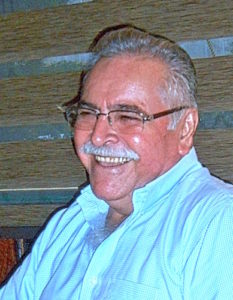 If you were to Google the meaning of self-taught a picture of Dario Veliz would surely pop up. His journey to success is filled with joy, hard work, and a relentless desire to be the very best – no matter the job. And to be the very best, you must never stop learning or improving.
If you were to Google the meaning of self-taught a picture of Dario Veliz would surely pop up. His journey to success is filled with joy, hard work, and a relentless desire to be the very best – no matter the job. And to be the very best, you must never stop learning or improving.
Dario left Durango at the age of 15 for Mazatlan filled with a zest for life, a love of sunsets and the ocean. He lived with his aunt and immediately got a job in construction; the boss would toss him all the grunt work and he completed them with a smile – for just one year. At 16 he approached the Playa Mazatlan Hotel for an apprenticeship position and was accepted. “I was in heaven. I was assistant to the bartender, snapping caps off beer bottles all day long, and then they would bring me dinner, and then tips, I couldn’t believe my luck.” Out of the 25 young men in the program only five were selected. Dario worked at Playa for 15 years and eventually became the maitre’ d. From there, he went to the Ramada for three years [was Los Sabalos] as the food and beverage manager.
During these years he did two important things. At the age of 20 he married Frances [who was 17], and he never stopped searching for mentors that he could learn from. A vision of a restaurant was slowly creeping into his head but he wasn’t ready, he needed to learn from the best and the brightest. He pursued and learned from Carlos Anderson [Señor Frogs, El Shrimp Bucket], Angel Cruz [La Costa Marina] and then he approached the owner of No Name Café. “That was my university, I learned everything about the restaurant business, customers, quality and service from these smart, successful men. I knew I didn’t want a hotel, I wanted a restaurant. I also saw a huge market for bbq ribs and the TexMex concept at the No Name Café – but it was run by an American and was only busy for five months of the year. I saw people lining up every Thursday and Sunday for all-you-can-eat ribs. Mexican customers maybe more difficult but they drink more, and once you know how to treat them they’ll come back every week.”
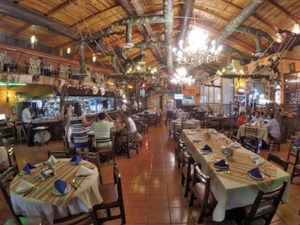
Part of Dario’s personal university was studying the Ray Kroc McDonald’s system. That kind of worked out well for McDonald’s, so why not introduce a similar quality control system for Casa Country. With quality control, consistency, and attention to service being top of mind, Dario and his four brothers opened Casa Country in 1993. He admired Lee Iacocca too; “start with good people, lay out the rules, communicate with your employees, motivate them and reward them. If you do all those things effectively, you can’t miss.” Iacocca also said “people always like to eat.” To learn more about motivation Dario proceeded to take the Dale Carnegie and Toastmasters courses. But the learning doesn’t stop there. He’s a voracious reader [non-fiction, business, marketing, anything to improve his restaurants] and he had heard of ISO 9000 in Canada and the US. ISO is essentially the bible of all operating manuals, [“the standards provide guidance and tools for companies and organizations who want to ensure that their products and services consistently meet customer’s requirements and that quality is consistently improved”.] Passing the ISO can take two years to qualify – to pass all the on-site tests, it’s expensive and Casa Country is one of the few restaurants in Mazatlan that has ISO practices. That was achieved ten years ago. Self-taught, oh yes.
Dario admits you can’t please everyone, and different people have different standards. He also strongly believes that ISO empowers all his employees to react in the same way each and every time to the rare complaint. Customers who return week after week [and they do] are guaranteed a consistent product. “If I can’t promise quality and consistency, then I’m nothing, I believe that much in a solid system.”
Now in their mid 60s, Dario and Frances have more time together. With three sons and a daughter all involved in the Casa Country Group, “I’m lucky, they all wanted in, they didn’t want to do anything else. I used to play tennis for hours every day, I’d go for every ball, I was a demon on the court…but with two knee replacements that is no longer possible, so I swim and will return to the golf course.” If the couple want a night off from the Casa Country restaurants they enjoy going to Vittorio’s, Los Arcos, Héctor’s Bistro [rack of lamb for Dario] and El Cuchupetas in Villa Union.
Dario’s daily routine is to wake at 5:30 a.m., swim and be at the restaurant by 8:30 a.m., and then he’s home for a siesta and returns to Casa Country around 6 p.m. I asked him why he spends so much time at the restaurant when his children are running it. He answers, “what else would I do? I like to quote Confucius, ‘choose a job you love, and you will never have to work a day in your life.’”
[La Casa Country Restaurant Bar is located Av. Camarón Sábalo, 916 5300 and is open every day at noon. “We have the largest parking lot in Mazatlan.” The restaurant seats 300 people, and there are 55 employees. The Cabo Casa Country also has 55 employees and seats 120. El Bife in Centro is a present from Dario Veliz to the Plazuela Machado. The beef is all bought in Torreón and Monterrey. The skirt steak is the most popular and the Casa Country group buys approximately 7.2 tons a year. If you want to be a waiter at Casa County you gotta know the country dances.]
Horacio Palencia – the king of banda is feeling romantic these days♥
By Sheila Madsen, January 2016
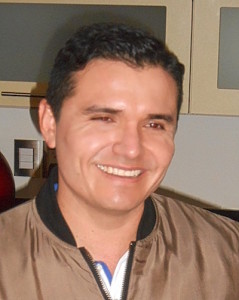 Setting up an interview with Horacio Palencia was not easy. He was either in LA, DF, and could only meet me on a Monday night, at 7p.m. in his recording studio/condo. Oh, and an interview in a coffee shop was not a good idea.
Setting up an interview with Horacio Palencia was not easy. He was either in LA, DF, and could only meet me on a Monday night, at 7p.m. in his recording studio/condo. Oh, and an interview in a coffee shop was not a good idea.
I did my usual research. Horacio is an award winning songwriter all right, but I didn’t understand just how famous he is until I arrived at his recording studio. The condo is awash in awards all neatly arranged on several shelves and dozens of BMI awards hang on his walls. In ten years, Horacio has become one of Mexico’s most popular banda/romantic singer/songwriters. The two slashes// are on purpose; he recently decided to perform, and he’s making the transition from banda to romantico. Singing his own love songs. The reason the singer/songwriter prefers not to be in public, he humbly explained, is because the women line-up for autographs, and follow him. An enthusiastic group of Guanajuato gals chose Mazatlan for a holiday because they may experience an Horacio sighting. His condo reception gave him a heads-up about the travelling fans and Horacio graciously met with them and happily signed autographs. He does like to meet his public – on his terms.
Horacio is a delightful, unassuming 34-year old man. Born in Rosario to a working class family – his father was a farmer – his uncle taught him to play the piano at eight. Being a typical Sinaloa family all he heard as a child, was the music of Sinaloa – banda. He started singing when he was 16 and at age 24 wrote De Ti Exclusivo for La Arrolladora Banda El Limon. From that hit he wrote the grammy award-winning song Mi Razon de Ser. With those proceeds Horacio bought a house for his family in Mazatlan. His career has only gone in one direction – up. He then went on to write Corazon Negro for the movie Salvando al Soldado Perez and if that wasn’t enough, the famous Mexican ranchera singer, Chavela Vargus adopted it and sang it many times before she died when she was 93. And more awards were bestowed.
With so many hits [he has written over 500 songs] and awards, Horacio has been travelling in the US and Mexico and has now had the opportunity to listen to other types of music. Today, he has chosen to focus on romantic acoustic, and to sing only his songs, which brings us to his upcoming tour – Un Concierto Acústico.
Gerson Leos, the musical arranger for all Horatio’s compositions, says “he’s the king of banda; there are two important banda songwriters in Mexico and he’s one of them. He’s famous for his compositions. What can I say? It’s my music and I love this romantic phase.” This “romantic phase” involves a 13 piece band with Gerson on the keyboard, plus a piano, cello, violins, percussions, sax and guitars. Gerson goes on to say “ the tour begins on February 9 and includes live performances as well as tv and radio. Horacio says “it’s a special show, it’s high quality with a live band, I love the violins, I love the sax, all set to a backdrop of well-made videos.”
Being young, Horacio is dreaming big. He’s busy learning English as he wants to be an international singer. He dreams about writing a song for Marc Anthony. He’d love to perform on stages in Paris, in New York and in LA, at the Microsoft Theatre with Romeo Santos or Michael Buble or Taylor Swift. Why not all three?
The king of banda songwriting quietly mentions “I was hidden as a songwriter, now I want people to know me, to see me perform, I want the audience to connect me with the songs I write.” Please welcome the romantic phase of Horacio Palencia.
[ You can follow Horacio on his “official” FB. Gerson Leos is a well-known jazz keyboard player and music arranger. You can see him on Thursdays and Fridays playing with his trio, Tecomate Jazz, at Pedro & Lola, around 8:30 p.m. Sandy Hill Pool is a certified ESL teacher and she kindly introduced me to Horacio.]
Alexis Félix’s magical mystery music tour
By Sheila Madsen (June, 2015)
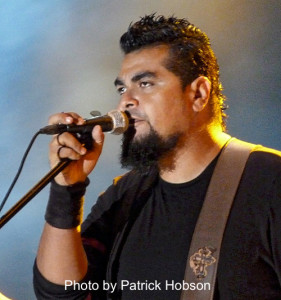 Two important events occurred in Mazatlan in 1975. Hurricane Olivia ripped through Mazatlan in October devastating the city and leaving 30 dead and thousands homeless. It was the worst hurricane since 1943. The second event was happier; the birth of Luis Alexis Félix Silva, son of blues singer Ginny and drummer Luis.
Two important events occurred in Mazatlan in 1975. Hurricane Olivia ripped through Mazatlan in October devastating the city and leaving 30 dead and thousands homeless. It was the worst hurricane since 1943. The second event was happier; the birth of Luis Alexis Félix Silva, son of blues singer Ginny and drummer Luis.
Alexis Félix enjoys saying he was born months after hurricane Olivia. It’s the songwriter in him and it’s the strong statements inked on his arm [never again] that make him offer up these dramatic details. Alexis was to the musical manor born. His mother, Ginny Silva, was/is a famous soul/blues singer with the Tijuana group Los Stukas and his father is one of the best drummers in Mexico. Alexis was born in Mazatlan, his parents moved to Tijuana, played with Los Stukas, separated, divorced, and reunite today in various gigs and groups. At six years old he remembers watching his parents perform and loving it. “That’s what I want to do, I want to feel what they are feeling.”
Shifting between Tijuana and Mazatlan he started singing professionally when he was 14 with a band called Hamlet. He had no desire to be in drummer dad’s shadow, “when I was young, all I wanted to do was sing.” He left Hamlet and joined a Mazatlan band, Medusa – they toured for ten successful years all through Mexico. Still no instrument in sight. It wasn’t until he was 23 that the guitar attracted him – along with his young Canadian girlfriend Heather. Eventually, everyone got married – Alexis to the guitar and to Heather. They have three boys, all bilingual, all with Canadian and Mexican passports. Their world is as wide open as Alexis’s musical influences. He’s crazy about, well everyone. When you grow up watching Bugs Bunny, Sesame Street, The Muppets (Ernie and Kermit were his favourites) and with a mother who effortlessly belted out Aretha Franklin songs and a father who drummed like the guys in Earth Wind and Fire then you can’t possibly narrow your scope; it’s as large as the Pacific ocean.
I did manage to encourage him to finish these sentences: I am happiest when I am playing… “the blues.”
If you could play on any stage with anyone, dead or alive where and who would that be. Alexis practically curled up in a fetal position, scrunched up his face and finally said, “ok, it would be a Live Aid concert, with Led Zeppelin, Queen and Jimmy Hendrix. But I would be happy playing my guitar with Bob Marley or John Lennon, anywhere.”

Alexis was moaning, “you’re killing me, this is like a Rorschach test.” “Oh just relax, it’s nothing like a Roschach test, it’s simply Bernard Pivot’s classic questions, you’ll love this.”
What is your favourite word – peace
What is your least favourite word – anger
What turns you on creatively, spiritually or emotionally – passion
What turns you off – a bad attitude
What sound or noise do you hate – fear
What profession other than your own would you like to attempt – psychologist or an electrical engineer
What profession would you not like to do – a cop
If heaven exists, what would you like to hear God say when you arrive at the Pearly Gates – we’ve been waiting for you. Jimmy, Steve, and the rest of guys are in the room, let’s jam!
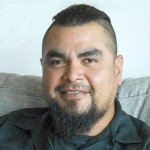 (October 2017: Alexis has returned to live in B.C. Canada. But he will be back this winter for several gigs – playing around town.Ah, the magical mystical world of music. Stay tuned or listen to him on MazatlanLife’s Bandstand)
(October 2017: Alexis has returned to live in B.C. Canada. But he will be back this winter for several gigs – playing around town.Ah, the magical mystical world of music. Stay tuned or listen to him on MazatlanLife’s Bandstand)

The passions of Alfredo Gómez Rubio
By Sheila Madsen, October 2014
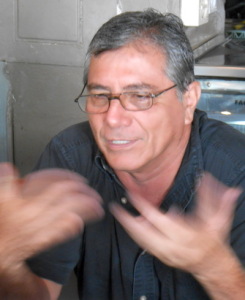 For 14 years Alfredo Gómez Rubio has been carrying a torch for Centro Historico. His vision and his passions have ensured this flame continues to burn bright. Just try selling “centro hysterical” in 2000 – not many buyers. Then, all eyes were on the Zona Dorada. Today, the eyeballs are all on Centro Historico and its revitalization.
For 14 years Alfredo Gómez Rubio has been carrying a torch for Centro Historico. His vision and his passions have ensured this flame continues to burn bright. Just try selling “centro hysterical” in 2000 – not many buyers. Then, all eyes were on the Zona Dorada. Today, the eyeballs are all on Centro Historico and its revitalization.
Alfredo is a delightful mass of energy; if he’s not talking on the phone, he’s scanning the screen or he’s tapping his iPad. He’s the consummate multitasker but he always keeps his brown eyes on the prize. Despite not having any electronic gadgets in the 70s and 80s he successfully managed to master English in a Catholic military school in California for grades 7 and 8. He completed his education at Monterrey Tech; graduating with two degrees – a BA in biochemistry, followed by an MBA.
Even though the Plazuela Machado was deserted in the mid 80s that didn’t stop Alfredo from launching a food processing plant (tuna, yogurt, shrimp) or opening an Irish pub on the corner of Heriberto Frias called Café Pacifico – where Vintage bar is located today. The entrepreneur continued his buying spree. In 1997, he opened Pedro & Lola (on December 22 the restaurant will turn 17 years old) and he bought the Melville Hotel in 1999. Lots of properties, but no players on this Mazatlan Monopoly board. Alfredo Gómez Rubio was not enjoying the way the dice were rolling in this game.
His Get Out of Jail Free card came in the form of a 2001 DC conference called Main Street. Cities around the world were desperate to reclaim their downtown core and this symposium of smart minds offered attendees the recipe to revitalize these areas. Alfredo returned to Mazatlan armed with inspiration and a solid plan. With a lot of help from old families, in 2002 Proyecto Centro Historico was born.
Alfredo never let go of the torch. He says, “our group focused on getting things done, we were really pragmatic, we had a process, it was none of this blah, blah, blah.” The original 2002 mission statement reads: “Proyecto Centro Histórico, A.C. (the Historic Center Project) is a multidisciplinary group of citizens and organizations that have joined forces to improve the conditions for the development of Old Mazatlan by enhancing its identity and heritage, based on four principles: organization, promotion, design and economic restructuring.” All the members of Proyecto Centro Historico are volunteers, except for one paid manager. Today, there are 15 members and Manrry Fuentevilla is the full-time manager.
There were the good times from 2002 – 2008 when Mazatlan was having a mini boom, the cruise ships were docking, condos were sprouting up faster than bamboo shoots and tourists were flocking to our beaches. “Centro was becoming cool and coffee was hot. Six years ago there were no coffee shops in Centro and now we have more coffee houses and spas than lawyers’ offices” says Alfredo. Despite the recent dark years, Alfredo goes on to say, “Centro has thrived as a community, it’s a place to meet your friends and we have many, many more choices such as Janet Blaser’s organic market, The Culinary Market, the Becerra’s Casa Garcia, Water’s Edge, and Héctor’s Bistro (formerly Molika). We have business people making investments, they are here for the long term, they love the history and they want to make Centro a success.”

Our mayor, Carlos Felton González, recently approved plans to spend $28 million pesos on five separate projects. Alfredo admitted the money would trickle down slowly (federal, state and city officials are all involved) but the first project to be completed “soon” is the Carpa Olivera. That’s the natural sea pool opposite the old Canucks, now La Chupiteria, beside Rodrigo Becerra’s mermaid monument. I frown at the name Carpa Olivera and Alfredo adds “don’t bother to translate that, it means nothing, it’s named after an old family. This is my pet project, I love to swim and imagine it lit up at night, with possibly a small food and drink concession overlooking the ocean. How (insert expletive) great would that be?”
As he gathers his electronic toys from the lunch table I think about how much I appreciate the passions of Alfredo Gómez Rubio. Centro’s time has come and we have the man with the magic torch to make it all happen.

Sixty minutes with Gabriela Rodriguez Garcia
By Sheila Madsen (September, 2014)
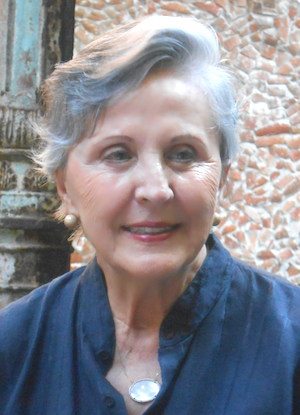
Gabriela Rodriguez Garcia quietly walks through the beautiful courtyard at Casa Garcia stopping to speak with friends and staff. I’ve met her briefly once before and she is gracious, elegant and calm. It’s as if she’s just come from a meditation session, she has a tranquil yet open manner. We quickly establish we were born in the same year and that I may call her by her first name, Gabriela.
She’s at home at Casa Garcia because it was her grandparent’s house, and now it belongs to her and her four sons. Before we meet the kids, let me tell you a little about her early days; it was an unusual path for a Mexican woman of her generation. Born in Mexico City she spent her childhood surrounded by the arts, culture and the buzz of DF. For her high school education, her parents decided on a Catholic boarding school in Chicago. She told me “I loved it, of course all my studies were in English, and I made many friends.” Her parents were originally from Mazatlan and the family would often return for holidays. She remembers staying at Casa Garcia with her grandmother and aunt – the house was on the second floor, and her grandmother rented out the ground floor for office space. It was a necessary business to pay the bills for the upkeep on this mansion.
After Chicago, Gabriela returned to DF and got her BA in economics. (Recently, she obtained her master’s degree in marketing and business. Stay with me, you’ll see this woman never stops.) In 1970, she married in DF and now we can meet the kids – the four Becerra brothers. From eldest to youngest: Roberto (engineer); Diego (chef); Rodrigo (sculptor, designer, architect, owner of La Mona Pizza); Rodolfo (business manager). When talking about her boys she becomes both animated and aggravated. They drove her crazy as active teenagers always in various accidents, some serious, other just enough to make her worry. “The worst was when Diego took up bullfighting, OMG it was terrible, I was really mad. But now they have settled down and all married nice girls. I think they even cook and do the dishes, they are good husbands.”
The family left DF in 1986 so the boys really spent (misspent?) their youth in Mazatlan. Raising four children didn’t curb Gabriela’s desires; she proceeded to learn Italian, join a book club, take a printmaking course from Glen Rogers, and still takes painting lessons from Lucila Santiago. She loves to travel and last year she met Diego in Spain and then went on to Paris. She begins her day with yoga, then meets friends at The Looney Bean, squeezes in an art or language class, lunches solo at home at 3 p.m., perhaps a small siesta then she’ll join friends for dinner at Héctor’s Bistro (formerly Molika) or Casa Garcia. Gabriela tries to see three movies a week, attend the Angela Peralta during the season and always reads a book before she goes to bed.
I asked her “when do you have time for family dinners?” “Well, we are 17 (each couple has two children) so it’s either at my house or here at Casa Garcia, but all of us make the time. I feel very Mexican, I love the culture and these family dinners are important. In 2009 when we began the renovation of this ruin, I was involved 100%. I’d supervise the architect, it was a great big job – remember it was full of rocks and stones. It was a large project but now that it’s over I just look after the gardens and plants. The boys manage the business and I can travel, I can do anything I want!”
Right now, Gabriela Rodriguez Garcia wants to wrap-up our interview. She has friends to meet, a Spanish play to see at the Angela Peralta, photos to take for her painting classes, a historic novel to read and she has some short stories she wants to write. My sixty minutes were up and as I watched her depart her beloved restored ruin I was left with this observation; Gabriela lives each and every day with a passionate serenity.
[Casa Garcia houses the restaurants El Presidio and Compañia Minera, the upscale Mexican cantina. It’s located on Niños Heroes and Mariano Escobedo in Centro. If you would like to learn more about the history of Casa Garcia please click here. ]

[The great artist died on August 15, 2023.] Antonio López Saenz was born in Mazatlan in 1936. He is perhaps Sinaloa’s most famous living artist and sculptor. He graciously agreed to an interview with the host of Artists Studios, Cecilia Sánchez Duarte. Of course this is not the first time Maestro has been interviewed, but it is the first time he’s allowed his originals to be reproduced digitally, or via giclee printing. All under the watchful marketing eye of his nephew, Victor Manuel López de la Paz. The artist spoke to Cecilia about his early life (he left Mazatlan for Mexico City when he was 15) and the great masters who influenced him. He also gives advice to all young artists: travel, be open, surround yourself with culture, and keep on being inspired. Antonio López Saenz still paints every single day. The conversation between Antonio and Cecilia is so warm, intimate and animated that to distill a section of it into English would be like ripping a finished canvass in half. This dialogue must remain whole. Besides, his work does not require a translation, it flows directly to your heart.

Meet Queen Lupita 1964 and Queen Lissy 1995 – one of the first mother daughter Carnaval queens
Lori – lean, lovely, live!
By Sheila Madsen
 On a humid Friday morning at 11 a.m singer Lori Davidson could not get a pulmonia. Her long auburn hair is swinging in the breeze, she’s wearing tight hot pink jeans teamed with a black tank top, revealing milky white skin, dusted with freckles. A single silver heart is dangling from her neck. Her corn flower blue eyes light up when I hand her a glass of cold water and she drinks in the ocean view. This gal’s a babe. And she couldn’t get a pulmonia?
On a humid Friday morning at 11 a.m singer Lori Davidson could not get a pulmonia. Her long auburn hair is swinging in the breeze, she’s wearing tight hot pink jeans teamed with a black tank top, revealing milky white skin, dusted with freckles. A single silver heart is dangling from her neck. Her corn flower blue eyes light up when I hand her a glass of cold water and she drinks in the ocean view. This gal’s a babe. And she couldn’t get a pulmonia?
This gal hails from San Francisco. Lori began playing the guitar when she was eight years old. The classical music phase lasted two years. The rock, blues, jazz and all the alternate sounds eventually wooed her away from Bach. She was a traditional young woman by day, attending Pepperdine University, but at night, she’d take a walk on the wild side; she’d hitch hike to Santa Barbara, sing and play her guitar in the streets earning a few dollars. Lori transferred to San Francisco State University, and graduated with a degree in English literature. What does a beautiful redhead, with a killer voice do with an English lit degree? You marry bass player Ken Embrey, take day jobs and sing at night.
Lori says: “Ken Embrey’s finger prints are all over my back. He challenged me, he pushed me, he gave me confidence in my singing, he did nothing but encourage me and make me a better performer and songwriter.” Wow, not many ex wives say that about their ex husbands. Together they played with Bay Area blues favourite, Tommy Castro, and performed in hundreds of other blues gigs. Together they “drove truck” for seven years. 5,300 miles every week from Sacramento to Dallas, 24/7. Together they bought houses, and a boat, wrote songs, and shared dreams.
Ken was playing bass for the legendary blues pioneer, John Lee Hooker. His only lead female singer got sick. This was no small venue, this was LA’s Hollywood Bowl, this was the annual Playboy Jazz Festival. Ken suggested his wife, Lori, to the humble sharecropper. The master of the R&B rock said, hell yes, bring her in. No rehearsal time, Lori does her sound check. The great John Lee Hooker has a single comment, “you can kick it up.” Lori Davidson steps on revolving stage and asks, as she always does at every gig, “who’s ready for the blues?” 18,000 people screamed and applauded, that’s a high this redhead will never forget.
Four years ago Lori and Ken sailed into Mazatlan to duck a storm. To everything there is a season, and it was time for Lori and Ken to go their separate ways. Lori’s dance card is booked solid in various Mazatlan venues. She’s a band with many names: The Lori Davidson Band, Wingin It!, Lori Live at Social, or Lori and Rob at Social. By day she reads (heck she’s written a book, Cedar Creek, you can find it on Kindle) and treats her voice as an instrument. She mists, drinks tea (with honey and lime), does vocal warm ups and then practices silence. “I’d admit I love to talk, so the most difficult part is not to speak two hours before a performance!”
I ask the question that has been on the tip of my tongue for months, “what’s it like to have a Mexican boyfriend?” Lori strokes her silver heart (we know who that belongs to) and simply says, “he’s the best of the modern world, he’s the best of the old fashioned world. He’s chivalrous in all the ways I want from a man.” This gal is lovin’ her man, her simple life, and the lack of consumerism she happily ditched in the United States. Lori wishes for nothing more, she wants nothing more. Well, perhaps one tiny wish – to sing with Bonnie Raitt.
(Find Lori and her gigs on The “Fairly Accurate Daily Music Schedule” – that will keep you current. To hear Lori on MazatlanLife’s Bandstand please click here.)

The Music Man from Mazatlan, Rafael Rodriquez
By Sheila Madsen
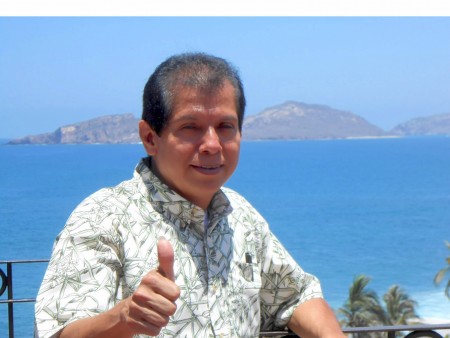
“Rafael, all you have to do is say his name and everyone knows who you are talking about…a very talented guitar player and singer, he draws people into his music, from romantic, to up-on-your feet dancing – he’s a true gentleman.” That’s an enthusiastic quote from Eileen Moore co-owner of the restaurant Topolo. Ardent fans of Rafael, Mary and Wally Glavind, have this to say: “Arriving in Mazatlan we had no idea it would be a musician that would make our stay so memorable. But sitting under the palapa listening to Rafael Rodriquez our first evening, we knew we had found something special; excellent music from a very talented guitarist and vocalist. From the first note we felt, rather than heard, the soul of Mexico.”
Rafael arrived for his interview two minutes early dressed in pressed khaki pants, and a beige shirt with a repeat pattern of bamboo shoots, socks on, shoes polished. He’s a serious, soft spoken man who only asked for a glass of tepid water; nothing too hot, nothing too cold to spoil his voice. At 49 this professional knows what he wants, he’s clearly focused on his goals. As with many musicians his journey has taken its twists and turns. There are three children, two ex wives, stints in various universities from Mazatlan, to Guadalajara, to UNAM in Mexico City and gigs with bands named Los Navegantes and Extasis. He briefly wanted to be an accountant (he’s good with numbers) but since he’s been strumming on a guitar from the age of eight, music became the food of his life and he played on.
The good with numbers bit is important; his first gigs were with Sr. Peppers, Gus Gus and Casa Club El Cid. He knew not to rely on tips, but to ask for a flat fee. And thirteen years later after he went solo, he still plays that way. Rafael does confess he counts on tips and sales of his cds. He also quickly adds that he pays into the musician union and the various branches of the tax department. This once upon a time wannabe bean counter takes care of business. Perhaps that’s why owners like Jen Woodman of Social, and the volunteers of Hospice dinner dance so enjoy hiring him. He shows up on time, every time, and puts on a really great show.
His music inspiration comes trova, Cuban trova. One trova definition is: to qualify as a trovador in Cuba you must be able to sing songs of your own composition, accompany yourself on the guitar and deal poetically with the song. Trova began around 1885 and the traditions continue today in Cuba. Rafael has composed four songs and just recorded them in Guadalajara. If you see him around town, perhaps ask him to play an original. I think it’s safe to say Rafael meets the criteria of a trova.
Born in Mazatlan, he learned English here and in his travels to universities. He has a genuine love for English music and studies the words, the nuances and meaning during the day. Currently, Adele has captured his interest and Rafael is learning some of her hits. Whenever I hear Rafael play, I want to tell people to stop talking and to listen. “Does this make you angry?” He’s matured and his response is: “At first I was very mad, I wanted to stop the music! Eventually I understood it’s part of my job. My voice is stronger, now I know I have a talent, I was born for this. I am very proud to be a musician. I enjoy every night. I imagine I am putting on a concert.” Rafael Rodriquez does not need to imagine he’s putting on a concert, he does.
(you can follow Rafael’s musical whereabouts on our “fairly accurate daily music schedule” or if you wish to hire Rafael just call his cell – 669 161 2772)


